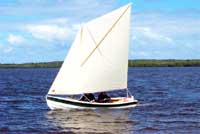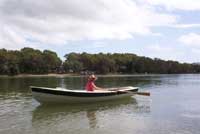|
design by Ross Lillistone - Esk, Queensland - Australia |
Thanks also for publishing the photo series on the two Bolger "Hope"s. The posting has generated a lot of interest, and it seems that people like the format with lots of photos and minimal descriptive comments. I'm in the process of putting together a series on the building of a Bolger "Harbinger" Catboat, at the request of one of your readers.
Attached are a few photos of my latest design, "Phoenix 3".
 |

|
(click images for larger views) |
|
I began her design seven years ago in the form of a half-model based on parameters I had laid down as being ideal (to me) for a row/sail/outboard beachcruiser of minimum dimensions and weight. The initial design lay dormant for several years until I was pushed into finishing for the prototype builder, Paul Hernes. The design aims included:
-
breadth of no more than 4' 6" at the gunwale to ensure reasonable rowing performance, and to allow bracing one's feet against the opposite side of the boat under sail;
-
length of at least 15' to give decent LWL and fine entry lines;
built-in buoyancy forrard and aft;
-
open layout to allow comfortable sitting position low down in the boat with back support at shoulder height, and to allow sleeping on the bottom without frames and side seating getting in the way;
-
properly proportioned rowing position;
-
sprit/sloop rig to allow all spars to stow inboard for trailering and for rowing with the rig stowed. Also, I was influenced by Phil Bolger when he pointed out that the sprit/sloop is one of the few free-standing rigs which can carry a jib without the need for shrouds and/or backstays. This is because the peak-sprit places the head of the sail in tension, which in turn, translates into luff tension in the jib;
-
glued-lapstrake construction - because it is my favourite method! Five wide planks per side, with a shallow V-bottom;
-
mast step, centreboard case, and open mast partner design: - to allow stepping of the mast easily from beside the boat without lifting;
-
low, open well between mast step and forrard end of centreboard case for sowage of items such as anchors and lines;
-
small self-draining outboard well on the transom.
The photos are from the very first outing. Vital dimensions are: - 15ft x 4ft 6ins, sail area 103 sq.ft. Weight unknown, but easily lifted by two people. Planking 6mm (1/4in) plywood, decking and bulkheads also 6mm (1/4in) ply.
Plans are complete, but not yet ready for release. I only have an A4 (letter sized) printer, and the plans amount to 32 drawings at the moment, plus instructions. When I can get a few weeks free, I'll get everything onto larger sheets.
Best wises from Australia,
Ross Lillistone

|